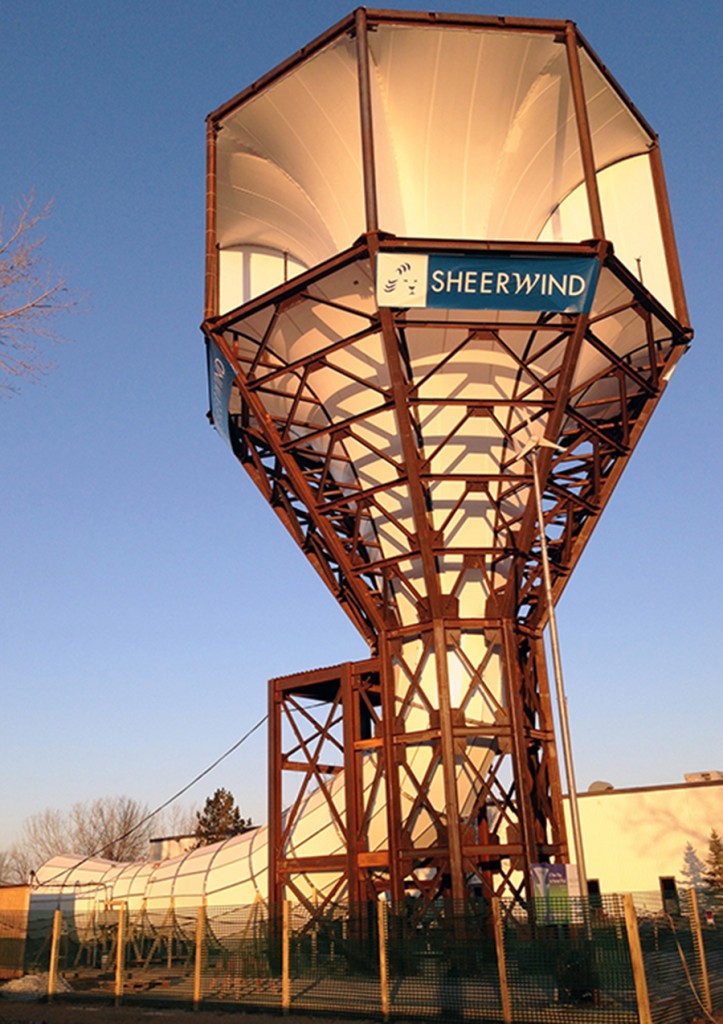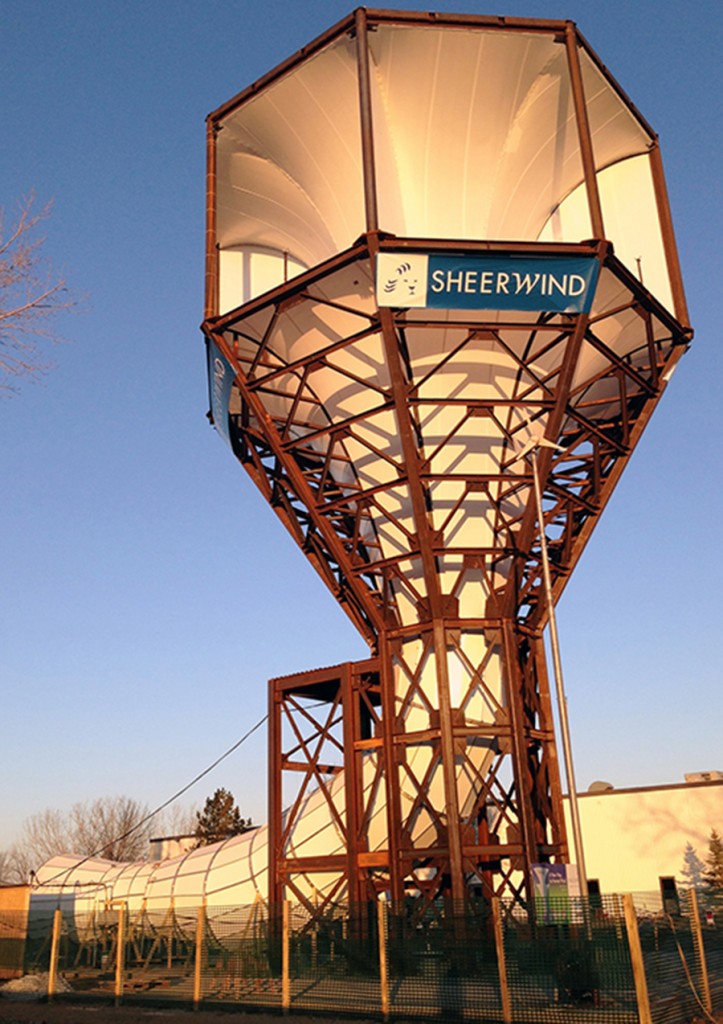December 5, 2013 – At this blog site we have looked at artificially-induced vortices as a novel approach to generating energy, but this one seems less like science fiction, a technology that captures wind from any direction and funnels and compresses it to drive a generator. It is called INVELOX which stands for INcreasing VELOcity of wind.
Wind turbines are mounted on top of towers. But INVELOX doesn’t require anything remotely like the infrastructure of windfarms. Instead it resembles a giant funnel attached to a ground-based generator. Inside the funnel is a wind turbine and as wind gets captured it funnels through an ever narrowing passage which accelerates its speed. The physics behind the technology is known as the Venturi effect and works like the head you put on your garden hose to up the pressure when watering plants.
The INVELOX form factor is much smaller than existing wind turbines standing about half the height (see image below) and the turbine blades within the funnel are 84% smaller than those found on traditional wind towers. And when you add the higher energy output that comes from accelerating the wind through the funnel you have what looks like a winning combination.
The developer is a company called SheerWind, based in Minneapolis, Minnesota. Each INVELOX can produce a windstream within the funnel of 12 meters (40 feet) per second and enough energy to power up to 25,000 homes.
The technology has an additional advantages over other windpower technologies. Besides being bird and bat friendly, its footprint is smaller, it produces less noise because there are no outside moving parts, it can be maintained by ground-level crews with no high wire act, you don’t have to stop it when wind speeds exceed levels that could damage turbine blades, and it is omnidirectional when capturing wind.
SheerWind states that INVELOX can operate with wind speeds as low as 3.2 kilometers (2 miles) per hour and generates electricity at a cost of less than 2 cents per kilowatt hour.
The design can be scaled from small to large, for rooftop funnels on buildings, backyard funnels for homes, to utility-sized funnels for grid-based power generation.













I’m doubtful this approach will actually be much better than the Coger International’s Hydro-Electric Converter, but it looks like a lot smarter technical people, who reject Nigerian ingenuity, are behind it. Wind power principles are actually pretty simple, and GE knows them all. Maximum power produced is proportional to the cube of wind speed times the area swept by the blades times 58%. No wind power system can ever work better than that. Since site selection is the only way wind power operators can increase wind speed, the easiest approach to more power is increasing blade diameter, which increases swept area as a square function of the increase.
The SheerWind approach does in fact produce higher wind speed in the venturi throat, but it does so by giving up much of the wind mass flow, so the net energy leaving the venturi throat to drive the turbine will never exceed 58% of the wind energy that impinges upon the funnel intake area. Given wind speeds over 8 mph, conventional wind turbine blades of the same swept area as the funnel intake would actually produce more energy. Looks like capital costs are much higher than conventional wind turbines. This might be a good rugged design approach for areas subject to very high winds, where destruction of conventional turbines would be a major issue. The company’s own published figures suggest a farm system that incorporates an existing silo as the basic tower structure would likely cost $10,000 per kW of installed capacity. This will always be a niche technology.
By niche can you see one of these on commercial buildings as a supplementary energy resource?
By niche can you see one of these on commercial buildings as a supplementary energy resource?
Not really. Commercial buildings are generally sited in areas well served by electrical grids. Capital costs of large pylon mounted wind turbines normally run about $3,000 kW of installed capacity. Why would any commercial operator want to invest $10,000 to produce the same power result as investing $3,000?
I’d like to see some independent data collection this approach before I commit to anything, but I do like to concept. Though there is a lot additional construction required for the funnel, it is simple construction and may not add that much to the cost over traditional turbines.
If their claims about lower operating costs and increased generation due to the lower cut-in wind speeds needed, it may come out to be competitive for production. The fact that the turbine is enclosed, this design may add to the life of the moving parts in the system.